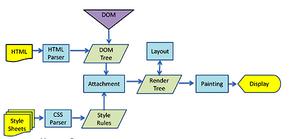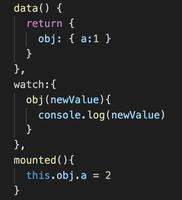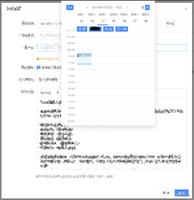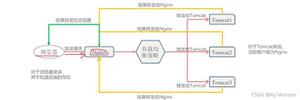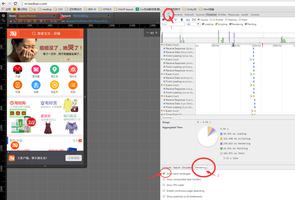React 应用的性能优化之路

本文讲的是React 应用的性能优化之路,
要点梗概
React 应用主要的性能问题在于多余的处理和组件的 DOM 比对。为了避免这些性能陷阱,你应该尽可能的在shouldComponentUpdate 中返回 false 。
简而言之,归结于如下两点:
加速 shouldComponentUpdate 的检查
简化 shouldComponentUpdate 的检查
免责声明!
文章中的示例是用 React + Redux 写的。如果你用的是其它的数据流库,原理是相通的但是实现会不同。
在文章中我没有使用 immutability (不可变)库,只是一些普通的 es6 和一点 es7。有些东西用不可变数据库要简单一点,但是我不准备在这里讨论这一部分内容。
React 应用的主要性能问题是什么?
- 组件中那些不更新 DOM 的冗余操作
- DOM 比对那些无须更新的叶子节点
- 虽则 DOM 比对很出色并加速了 React ,但计算成本是不容忽视的
React 默认的渲染行为是怎样的?
我们来看一下 React 是如何渲染组件的。
初始化渲染
在初始化渲染时,我们需要渲染整个应用
(绿色 = 已渲染节点)
每一个节点都被渲染 —— 这很赞!现在我们的应用呈现了我们的初始状态。
提出改变
我们想更新一部分数据。这些改变只和一个叶子节点相关
理想更新
我们只想渲染通向叶子节点的关键路径上的这几个节点
默认行为
如果你不告诉 React 别这样做,它便会如此
(橘黄色 = 浪费的渲染)
哦,不!我们所有的节点都被重新渲染了。
React 的每一个组件都有一个 shouldComponentUpdate(nextProps, nextState) 函数。它的职责是当组件需要更新时返回true , 而组件不必更新时则返回 false 。返回 false 会导致组件的 render 函数不被调用。React 总是默认在shouldComponentUpdate 中返回 true,即便你没有显示地定义一个 shouldComponentUpdate 函数。
// 默认行为shouldComponentUpdate(nextProps, nextState) {
return true;
}
这就意味着在默认情况下,你每次更新你的顶层级的 props,整个应用的每一个组件都会渲染。这是一个主要的性能问题。
我们如何获得理想的更新?
尽可能的在 shouldComponentUpdate 中返回 false 。
简而言之:
加速 shouldComponentUpdate 的检查
简化 shouldComponentUpdate 的检查
加速 shouldComponentUpdate 检查
理想情况下我们不希望在 shouldComponentUpdate 中做深等检查,因为这非常昂贵,尤其是在大规模和拥有大的数据结构的时候。
class Item extends React.component { shouldComponentUpdate(nextProps) {
// 这很昂贵
return isDeepEqual(this.props, nextProps);
}
// ...
}
一个替代方法是_只要对象的值发生了变化,就改变对象的引用_。
const newValue = { ...oldValue
// 在这里做你想要的修改
};
// 快速检查 —— 只要检查引用
newValue === oldValue; // false
// 如果你愿意也可以用 Object.assign 语法
const newValue2 = Object.assign({}, oldValue);
newValue2 === oldValue; // false
在 Redux reducer 中使用这个技巧:
// 在这个 Redux reducer 中,我们将改变一个 item 的 descriptionexport default (state, action) {
if(action.type === 'ITEM_DESCRIPTION_UPDATE') {
const { itemId, description } = action;
const items = state.items.map(item => {
// action 和这个 item 无关 —— 我们可以不作修改直接返回这个 item
if(item.id !== itemId) {
return item;
}
// 我们想改变这个 item
// 这会保留原本 item 的值,但
// 会返回一个更新过 description 的新对象
return {
...item,
description
};
});
return {
...state,
items
};
}
return state;
}
如果你采用这个方法,那你只需在 shouldComponentUpdate 函数中作引用检查
// 超级快 —— 你所做的只是检查引用!shouldComponentUpdate(nextProps) {
return isObjectEqual(this.props, nextProps);
}
isObjectEqual 的一个实现示例
const isObjectEqual = (obj1, obj2) => { if(!isObject(obj1) || !isObject(obj2)) {
return false;
}
// 引用是否相同
if(obj1 === obj2) {
return true;
}
// 它们包含的键名是否一致?
const item1Keys = Object.keys(obj1).sort();
const item2Keys = Object.keys(obj2).sort();
if(!isArrayEqual(item1Keys, item2Keys)) {
return false;
}
// 属性所对应的每一个对象是否具有相同的引用?
return item2Keys.every(key => {
const value = obj1[key];
const nextValue = obj2[key];
if(value === nextValue) {
return true;
}
// 数组例外,再检查一个层级的深度
return Array.isArray(value) &&
Array.isArray(nextValue) &&
isArrayEqual(value, nextValue);
});
};
const isArrayEqual = (array1 = [], array2 = []) => {
if(array1 === array2) {
return true;
}
// 检查一个层级深度
return array1.length === array2.length &&
array1.every((item, index) => item === array2[index]);
};
简化 shouldComponentUpdate 检查
先看一个_复杂_的 shouldComponentUpdate 示例
// 关注分离的数据结构(标准化数据)const state = {
items: [
{
id: 5,
description: 'some really cool item'
}
]
// 表示用户与系统交互的对象
interaction: {
selectedId: 5
}
};
如果这样组织你的数据,会使得在 shouldComponentUpdate 中进行检查变得_困难_
import React, { Component, PropTypes } from 'react'class List extends Component {
propTypes = {
items: PropTypes.array.isRequired,
iteraction: PropTypes.object.isRequired
}
shouldComponentUpdate (nextProps) {
// items 中的元素是否发生了改变?
if(!isArrayEqual(this.props.items, nextProps.items)) {
return true;
}
// 从这里开始事情会变的很恐怖
// 如果 interaction 没有变化,那可以返回 false (真棒!)
if(isObjectEqual(this.props.interaction, nextProps.interaction)) {
return false;
}
// 如果代码运行到这里,我们知道:
// 1. items 没有变化
// 2. interaction 变了
// 我们需要 interaction 的变化是否与我们相干
const wasItemSelected = this.props.items.any(item => {
return item.id === this.props.interaction.selectedId
})
const isItemSelected = nextProps.items.any(item => {
return item.id === nextProps.interaction.selectedId
})
// 如果发生了改变就返回 true
// 如果没有发生变化就返回 false
return wasItemSelected !== isItemSelected;
}
render() {
<div>
{this.props.items.map(item => {
const isSelected = this.props.interaction.selectedId === item.id;
return (<Item item={item} isSelected={isSelected} />);
})}
</div>
}
}
问题1:shouldComponentUpdate 体积庞大
你可以看出一个非常简单的数据对应的 shouldComponentUpdate 即庞大又复杂。这是因为它需要知道数据的结构以及它们之间的关联。shouldComponentUpdate 函数的复杂度和体积只随着你的数据结构增长。这_很容易_导致两点错误:
- 在不应该返回 false 的时候返回 false(应用显示错误的状态)
- 在不应该返回 true 的时候返回 true(引发性能问题)
为什么要让事情变得这么复杂?你只想让这些检查变得简单一点,以至于你根本就不必考虑它们。
问题2:父子级之间强耦合
通常而言,应用都要推广松耦合(组件对其它的组件知道的越少越好)。父组件应该尽量避免知晓其子组件的工作原理。这就允许你改变子组件的行为而无须让父级知晓这些变化(假设 PropsTypes 保持不变)。它还允许子组件独立运转,而不必让父级紧密的控制其行为。
解决办法:压平你的数据
通过压平(合并)你的数据结构,你可以重新使用非常简单的引用检查来看是否有什么发生了变化。
const state = { items: [
{
id: 5,
description: 'some really cool item',
// interaction 现在存在于 item 的内部
interaction: {
isSelected: true
}
}
}
};
这样组织你的数据使得在 shouldComponentUpdate 中做检查变得_简单_
import React, {Component, PropTypes} from 'react'class List extends Component {
propTypes = {
items: PropTypes.array.isRequired
}
shouldComponentUpdate(nextProps) {
// so easy,麻麻再也不用担心我的更新检查了
return isObjectEqual(this.props, nextProps);
}
render() {
<div>
{this.props.items.map(item => {
return (
<Item item={item}
isSelected={item.interaction.isSelected} />)
})}
</div>
}
}
如果你想要更新 interaction 你就改变整个对象的引用
// redux reducerexport default (state, action) => {
if(action.type === 'ITEM_SELECT') {
const { itemId } = action;
const items = state.items.map(item => {
if(item.id !== itemId) {
return item;
}
// 改变整个对象的引用
return {
...item,
interaction: {
isSelected: true
}
}
})
return {
...state,
items
};
}
return state;
};
误区:引用检查与动态 props
一个创建动态 props 的例子
class Foo extends React.Component { render() {
const {items} = this.props;
// 这个对象每次都有一个新的引用
const newData = { hello: 'world' };
return <Item name={name} data={newData} />
}
}
class Item extends React.Component {
// 即便前后两个对象的值相同,检查也总会返回true,因为 `data` 每次都会得到一个新的引用
shouldComponentUpdate(nextProps) {
return isObjectEqual(this.props, nextProps);
}
}
通常我们不会在组件中创建一个新的 props 把它传下来 。但是,这在循环中更为常见
class List exntends React.Component { render() {
const {items} = this.props;
<div>
{items.map((item, index) => {
// 这个对象每次都会获得一个新引用
const newData = {
hello: 'world',
isFirst: index === 0
};
return <Item name={name} data={newData} />
})}
</div>
}
}
这在创建函数时很常见
import myActionCreator from './my-action-creator';class List extends React.Component {
render() {
const {items, dispatch} = this.props;
<div>
{items.map(item => {
// 这个函数的引用每次都会变
const callback = () => {
dispatch(myActionCreator(item));
}
return <Item name={name} onUpdate={callback} />
})}
</div>
}
}
解决问题的策略
- 避免在组件中创建动态的 props
改善你的数据模型,这样你就可以直接把 props 传下来
- 把动态 props 转化成满足全等(===)的类型传下来
eg:
- boolean
- number
- string
const bool1 = true;const bool2 = true;
bool1 === bool2; // true
const string1 = 'hello';
const string2 = 'hello';
string1 === string2; // true
如果你实在需要传递动态对象,那就把它当作字符串传下来,再在子级进行解构
render() { const {items} = this.props;
<div>
{items.map(item => {
// 每次获得新引用
const bad = {
id: item.id,
type: item.type
};
// 相同的值可以满足严格的全等 '==='
const good = `${item.id}::${item.type}`;
return <Item identifier={good} />
})}
</div>
}
特殊情况:函数
- 如果可以的话,尽量避免传递函数。相反,让子组件自由的 dispatch 动作。这还有个附加的好处就是把业务逻辑移出组件。
- 在 shouldComponetUpdate 中忽略函数检查。这样不是很理想,因我们不知道函数的值是否变化了。
- 创建一个 data -> function 的不可变绑定。你可以在 componentWillReceiveProps 函数中把它们存到 state 中去。这样就不会在每一次 render 时拿到新的引用。这个方法极度笨重,因为你须要维护和更新一个函数列表。
- 创建一个拥有正确 this 绑定的中间组件。这也不够理想,因为你在层级中引入了一个冗余层。
- 任何其它你能够想到的、能够避免每次 render 调用时创建一个新函数的方法。
方案4 的示例
// 引入另外一层 'ListItem'<List>
<ListItem> // 你可以在这里创建正确的 this 绑定
<Item />
</ListItem>
</List>
class ListItem extends React.Component {
// 这样总能得到正确的 this 绑定,因为它绑定在了实例上
// 感谢 es7!
const callback = () => {
dispatch(doSomething());
}
render() {
return <Item callback={this.callback} item={this.props.item} />
}
}
工具
以上列出来的所有规则和技巧都是通过使用性能测量工具发现的。使用工具可以帮助你发现你的应用的具体性能问题所在。
console.time
这一个相当简单:
- 开始一个计时器
- 做点什么
- 停止计时器
一个比较好的做法是使用 Redux 中间件:
export default store => next => action => { console.time(action.type)
// `next` 是一个函数,它接收 'action' 并把它发送到 ‘reducers' 进行处理
// 这会导致你应有的一次重渲
const result = next(action);
// 渲染用了多久?
console.timeEnd(action.type);
return result;
};
用这个方法可以记录你应用的每一个 action 和它引起的渲染所花费的时间。你可以快速知道哪些 action 渲染时间最长,这样当你解决性能问题时就可以从那里着手。拿到时间值还能帮助你判断你所做的性能优化是否奏效了。
React.perf
这个工具的思路和 console.time 是一致的,只不过用的是 React 的性能工具:
- Perf.start()
- do stuff
- Perf.stop()
Redux 中间件示例:
import Perf from 'react-addons-perf';export default store => next => action => {
const key = `performance:${action.type}`;
Perf.start();
// 拿到新的 state 重渲应用
const result = next(action);
Perf.stop();
console.group(key);
console.info('wasted');
Perf.printWasted();
// 你可以在这里打印任何你感兴趣的 Perf 测量值
console.groupEnd(key);
return result;
};
与 console.time 方法类似,它能让你看到你每一个 action 的性能指标。更多关于 React 性能 addon 的信息请点击这里
浏览器工具
CPU 分析器火焰图表在寻找你的应用程序的性能问题时也能发挥作用。
在做性能分析时,火焰图表会展示出每一毫秒你的代码的 Javascript 堆栈的状态。在记录的时候,你就可以确切地知道任意时间点执行的是哪一个函数,它执行了多久,又是谁调用了它。—— Mozilla
原文发布时间为:2016年06月09日
本文来自云栖社区合作伙伴掘金,了解相关信息可以关注掘金网站。
以上是 React 应用的性能优化之路 的全部内容, 来源链接: utcz.com/z/381624.html



